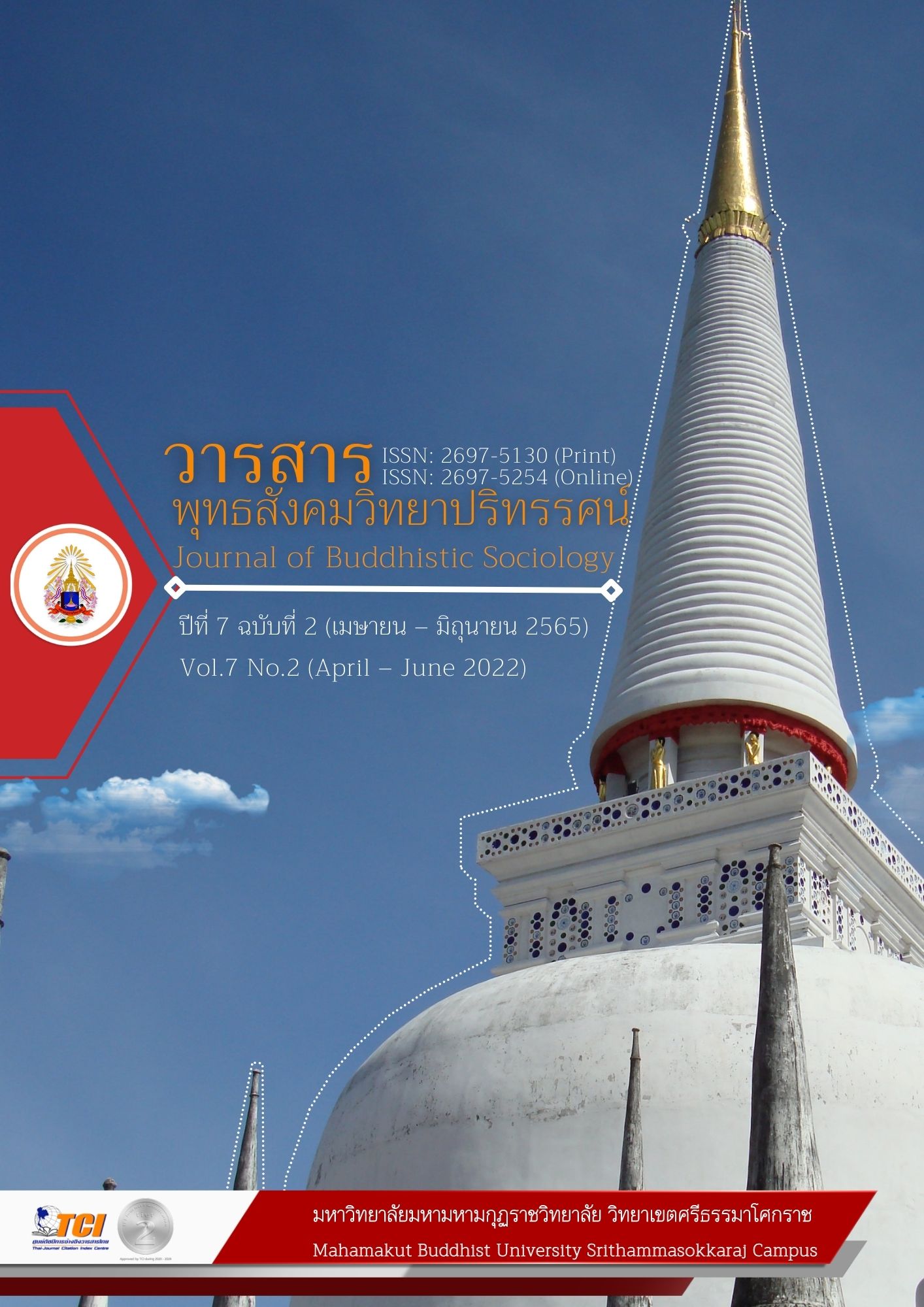THE APPLICATION OF BUDDHIST DHAMMA PRINCIPLES OF PRISONERS IN NAKHON SI THAMMARAT CENTRAL JAIL
Main Article Content
Abstract
This thematic paper aimed to study 1) the application of Buddhist dhamma principles of prisoners in Nakhon Si Thammarat central jail, 2) problems and obstacles to the application of Buddhist dhamma principles of prisoners in Nakhon Si Thammarat central jail, and 3) the solutions for problems and obstacles of the application of Buddhist dhamma principles of prisoners in Nakhon Si Thammarat central jail. This mixed methods research included quantitative research using 6,286 prisoners in April 2020 as the research population. The researcher determined the sample size by applying Krejcie and Morgan's table measurement and using stratified random sampling to get the sample group of 361 people. The research instrument for data collection was a questionnaire with closed and open-ended questions. The statistics for data analysis were frequency, percentage, arithmetic mean, and standard deviation. For qualitative research, there were 12 key informants selected by purposive sampling. The research instrument for data collection was the interview. Then the data were analyzed using content analysis accompanied by the context
The findings were as follows;
1. Overall, the prisoners in Nakhon Si Thammarat central jail applied the Buddhist dhamma principles at a high level. When considering each aspect in descending order of the average, it was found that the aspect of Samanattata had the highest average. Next below was Atthacariya, and the aspect of Dana had the lowest average. When classifying in terms of sexes, ages, degrees of education, nature of the offense, and control boundary, it was found that overall, the application of Buddhist dhamma principles of prisoners in Nakhon Si Thammarat central jail was high.
2. For problems and obstacles to the application of Buddhist dhamma principles of prisoners in Nakhon Si Thammarat central jail, it was found that the respondents mainly expressed their opinions about problems and obstacles in Dana: the prisoners had selfish behavior, lack of sharing, lack of sacrifice, and lack of financial income. The next below was Piyavaca: the prisoner's speech was impolite, rude, and sarcastic because they live in a society with different cultures and languages. For the aspect of Samanattata, the personal behavior of the prisoners was as follows: they did not know their responsibility and broke the rules. The respondents less expressed their opinions on the problems and obstacles.
3. For the solutions to problems and obstacles for the application of Buddhist dhamma principles of prisoners in Nakhon Si Thammarat central jail, it was found that from in-depth interviews, the informants commented on solutions to problems and obstacles as follows: organizing a training program on character development by staff or by inviting external speakers to educate and increase morals and ethics, including inserting various activities could help create ideas of helping each other, focus more on helping others, and create a feeling of good behavior in prison.
Article Details

This work is licensed under a Creative Commons Attribution-NonCommercial-NoDerivatives 4.0 International License.
References
กรีฑา คงพยัคฆ์. (2562). การประยุกต์ใช้หลักสังคหวัตถุธรรมในการบริการสาธารณะของเทศบาล ตำบลจันดี อำเภอฉวาง จังหวัดนครศรีธรรมราช. ใน สารนิพนธ์รัฐศาสตรมหาบัณฑิต. มหาวิทยาลัยมหามกุฏราชวิทยาลัย.
ชัยวัฒน์ สุรวิชัย. (2560). การใช้ชีวิตให้มีคุณค่าในแต่ละวัน. เรียกใช้เมื่อ 23 มีนาคม 2563 จาก https://siamrath.co.th/n/8571
พระธนพร คุณสมฺปนฺโน (อาคะนิช) และคณะ. (2560). การประยุกต์ใช้หลักสังคหวัตถุ 4 ในการดำเนินชีวิตของประชาชนบ้านศิลา ตำบลศิลา อำเภอเมืองขอนแก่น จังหวัดขอนแก่น. ใน รายงานการวิจัยรัฐศาสตรบัณฑิต สาขารัฐศาสตร์การปกครอง. มหาวิทยาลัยมหามกุฏราชวิทยาลัย.
พระพรหมคุณาภรณ์ (ป.อ. ปยุตโต). (2550). ธรรมนูญชีวิต. กรุงเทพมหานคร: โรงพิมพ์สำนักงานพระพุทธศาสนาแห่งชาติ.
พระวิศรุต ธิตโสภโณ (อนุวงษา). (2561). การประยุกต์ใช้หลักสังคหวัตถุ 4 ในการพัฒนาชุมชนของพระสังฆาธิการในเขตอำเภอเมือง จังหวัดเชียงราย. ใน วิทยานิพนธ์รัฐศาสตรมหาบัณฑิต. มหาวิทยาลัยมหามกุฏราชวิทยาลัย.
พระสุนทร ธมฺมธโร (บุญคง). (2560). การประยุกต์ใช้หลักสังคหวัตถุ 4 ในชุมชนวัดหนองสนม จังหวัดระยอง. ใน วิทยานิพนธ์พุทธศาสตรมหาบัณฑิต สาขาพระพุทธศาสนา. มหาวิทยาลัยมหาจุฬาลงกรณราชวิทยาลัย.


